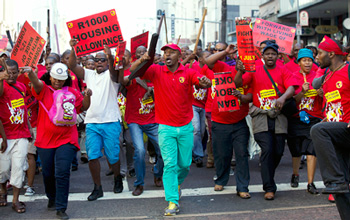

Vol. 78/No. 26 July 21, 2014

|
| Reuters/Rogan Ward |
| Members of National Union of Metalworkers protest in Durban, South Africa, July 1 at start of strike for wage raise, end to temporary jobs filled by “labor brokers,” and other demands. |
The Metalworkers kicked off their fight with marches in Cape Town, George, Durban, Port Elizabeth, Kwazulu-Natal, East London and Johannesburg. The heart of the strikes are in factories that make parts for mines, automobiles and telecommunications equipment.
General Motors shut down its Port Elizabeth factory July 3 due to a shortage of auto parts. BMW has also cut down its production.
Strikers are demanding a 12 percent wage increase. Bosses are offering 10 percent for the lowest-paid workers and between 7 and 8 percent for the rest. The central issue is the union’s demand to end the system of labor brokers and for a one-year contract.
“If you are working permanently you have benefits, wages, medical aid and all that, but if you are employed by a broker, it’s not the same,” Mphumzi Maqungo, national treasurer of the Metalworkers union, told the Militant by phone July 4. “The worker employed by the broker says, ‘We are on the same line, the same shift, the same job, why can’t I have the same benefits?’”
The bosses want a three-year contract. “But food is going up, everything just goes up,” he said. “The strategy for us is we want one collective negotiation for auto, tires, parts.”
The union is also demanding bosses not implement a youth wage subsidy passed by the African National Congress government that gives bosses an incentive to push older workers out and a new lever to sow divisions. The measure “reimburses” companies for part of the wages of first-time workers aged 18-29.
In a July 4 press release, the Steel and Engineering Industries Federation of Southern Africa, which represents 20 percent of 10,500 companies being struck by more than half of the workers, said there was “no way” industry bosses “would accede to NUMSA’s demand to desist from ever using the services of labour brokers.”
Miners ‘fight for next generation’
Miners at Anglo American Platinum, Impala and Lonmin, the world’s top three platinum producers, went back to work June 25. The miners, organized by the Association of Mineworkers and Construction Union, had been on strike since Jan. 23.At a mass meeting at the Rustenburg soccer stadium, miners approved a three-year contract that included a 20 percent annual wage increase, amounting to about a 1,000 rand ($93) monthly raise each year for the lowest-paid workers. The highest paid will get up to an 8 percent increase.
The end of the strike “is not necessarily a time of celebration,” said Lonmin Chief Executive Ben Magara, flanked by his counterparts at Amplats and Impala at a press conference in Johannesburg. “There are no winners.”
Many miners see it differently. “I don’t care what I’ve lost in unpaid wages, we are doing this for the next generation of mineworkers,” a worker from Impala, who did not want to be identified, told the Johannesburg-based Financial Mail. “Our children must not inherit this situation when their time comes to work in the mines.”
The biggest gain was narrowing the gap between the highest and lowest paid worker, AMCU President Joseph Mathunjwa told the Militant. “This gap of inequality is still there, but we were able to crack it.”
“There is still a lot to be done,” Mathunjwa said. “Many mine workers still live in hostels, with eight in a single room. The issue of safety is still a challenge.”
At the end of 2012, 100,000 workers at platinum, gold, chrome and other mines stopped work, demanding a minimum monthly wage of 12,500 rand. The leadership of the National Union of Mineworkers opposed the strike, leading many miners to join AMCU, which is now the main union in the platinum belt.
The NUM and Metalworkers are both affiliated with the Congress of South African Trade Unions, the main union federation in the country, which is allied with the ruling African National Congress and the South African Communist Party. Earlier this year some COSATU officials called for the expulsion of the Metalworkers because the union wouldn’t back the ANC in the May elections.
Bosses are concerned about the precedent set by the platinum miners’ strike victory. A June 25 editorial in Business Day Live said the strike settlement “is no more than a reprieve, a breathing space that must be used to restructure the mining industry so as to avoid a repeat performance in three years’ time — or sooner if other sectors are impressed enough with the settlement terms to follow the platinum miners’ lead.”
On July 4, three days after the Metalworkers strike began, some 2,000 members of the National Union of Mineworkers struck Impala’s Marula platinum mine, demanding the same concessions wrested by their fellow platinum miners organized by AMCU.
Related articles:
Farmers, miners in western Turkey discuss challenges facing rural toilers
On the Picket Line
Front page (for this issue) |
Home |
Text-version home